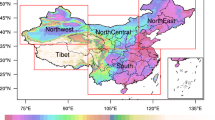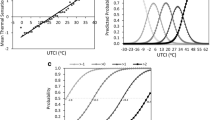Abstract
The perceived temperature has been changing rapidly under global warming, and its related extremes have significant impacts on labor productivity and human health. Although numerous thermal indices have been developed to quantify the perceived temperature, impact assessments have not been conducted comprehensively. The lack of exploring the nonlinearity and linearity inherent in thermal indices will lead to biased conclusions. We conduct a comprehensive investigation of 161 indices to create an ensemble of selected thermal indices that represent the linear and nonlinear relationships of climatic conditions and quantify the changes in the perceived temperature and related extremes. Here we find that the increase in the mean perceived temperature can be strongly exaggerated by using nonlinear indices or linear indices that only consider the combined effect of high temperature and humidity. Wind speed incorporated into the schemes of linear indices can largely offset the increase in the perceived temperature induced by the high relative humidity. These two divergent changes can be further enhanced in future exposure to heat stress. Furthermore, our findings reveal an amplification of heatwave durations induced by the combined effects of multiple variables for all thermal indices. Such an amplification leads to a cascade of relatively short-duration heatwaves evolving into super long-lasting heatwaves which are particularly pronounced over low-latitude areas.








Similar content being viewed by others
Data and materials availability
We acknowledge and thank the climate modeling groups (listed in Supplementary Table S2) in the World Climate Research Programme’s Working Group on Coupled Modelling (which is responsible for CMIP5) for generating their model outputs and making them available. We would also like to express our sincere gratitude to the editor and anonymous reviewers for their constructive comments and suggestions.
References
Argueso D, Di Luca A, Perkins-Kirkpatrick SE, Evans JP (2016) Seasonal mean temperature changes control future heat waves. Geophys Res Lett 43(14):7653–7660. https://doi.org/10.1002/2016gl069408
Basu R, Samet JM (2002) Relation between elevated ambient temperature and mortality: a review of the epidemiologic evidence. Epidemiol Rev 24(2):190–202. https://doi.org/10.1093/epirev/mxf007
Bobb JF, Peng RD, Bell ML, Dominici F (2014) Heat-related mortality and adaptation to heat in the United States. Environ Health Perspect 122(8):811–816. https://doi.org/10.1289/ehp.1307392
Bongaarts J, O’Neill BC (2018) Global warming policy: is population left out in the cold? Science 361(6403):650–652. https://doi.org/10.1126/science.aat8680
Carvalho KS, Wang S (2019) Characterizing the Indian Ocean sea level changes and potential coastal flooding impacts under global warming. J Hydrol 569:373–386. https://doi.org/10.1016/j.jhydrol.2018.11.072
de Freitas CR, Grigorieva EA (2015) A comprehensive catalogue and classification of human thermal climate indices. Int J Biometeorol 59(1):109–120. https://doi.org/10.1007/s00484-014-0819-3
de Freitas CR, Grigorieva EA (2017) A comparison and appraisal of a comprehensive range of human thermal climate indices. Int J Biometeorol 61(3):487–512. https://doi.org/10.1007/s00484-016-1228-6
Delworth TL, Mahlman JD, Knutson TR (1999) Changes in heat index associated with CO2-induced global warming. Clim Change 43(2):369–386. https://doi.org/10.1023/A:1005463917086
Diffenbaugh NS, Pal JS, Giorgi F, Gao XJ (2007) Heat stress intensification in the Mediterranean climate change hotspot. Geophys Res Lett 34:11. https://doi.org/10.1029/2007gl030000
Dukesdobos FN (1981) Hazards of heat exposure—a review. Scand J Work Environ Heat 7(2):73–83. https://doi.org/10.5271/sjweh.2560
Dunne JP, Stouffer RJ, John JG (2013) Reductions in labour capacity from heat stress under climate warming. Nat Clim Change 3(6):563–566. https://doi.org/10.1038/Nclimate1827
Fischer EM, Knutti R (2013) Robust projections of combined humidity and temperature extremes. Nat Clim Change 3(2):126–130. https://doi.org/10.1038/Nclimate1682
Fischer EM, Schar C (2010) Consistent geographical patterns of changes in high-impact European heatwaves. Nat Geosci 3(6):398–403. https://doi.org/10.1038/Ngeo866
Fischer EM, Oleson KW, Lawrence DM (2012) Contrasting urban and rural heat stress responses to climate change. Geophys Res Lett. https://doi.org/10.1029/2011gl050576
Fischereit J, Schlunzen KH (2018) Evaluation of thermal indices for their applicability in obstacle-resolving meteorology models. Int J Biometeorol 62(10):1887–1900. https://doi.org/10.1007/s00484-018-1591-6
Frieler K, Meinshausen M, von Deimling TS, Andrews T, Forster P (2011) Changes in global-mean precipitation in response to warming, greenhouse gas forcing and black carbon. Geophys Res Lett. https://doi.org/10.1029/2010gl045953
Gasparrini A et al (2015a) Temporal variation in heat-mortality associations: a multicountry study. Environ Health Perspect 123(11):1200–1207. https://doi.org/10.1289/ehp.1409070
Gasparrini A et al (2015b) Mortality risk attributable to high and low ambient temperature: a multicountry observational study. Lancet 386(9991):369–375. https://doi.org/10.1016/S0140-6736(14)62114-0
Hanna EG, Tait PW (2015) Limitations to thermoregulation and acclimatization challenge human adaptation to global warming. Int J Environ Res Public Health 12(7):8034–8074. https://doi.org/10.3390/ijerph120708034
Horton DE, Johnson NC, Singh D, Swain DL, Rajaratnam B, Diffenbaugh NS (2015) Contribution of changes in atmospheric circulation patterns to extreme temperature trends. Nature 522(7557):465–469. https://doi.org/10.1038/nature14550
Johnson NC, Xie SP, Kosaka Y, Li XC (2018) Increasing occurrence of cold and warm extremes during the recent global warming slowdown. Nat Commun. https://doi.org/10.1038/s41467-018-04040-y
Kovats RS, Hajat S (2008) Heat stress and public health: a critical review. Annu Rev Publ Health 29:41. https://doi.org/10.1146/annurev.publhealth.29.020907.090843
Li JF, Chen YQD, Gan TY, Lau NC (2018) Elevated increases in human-perceived temperature under climate warming. Nat Clim Change 8(1):43–47. https://doi.org/10.1038/s41558-017-0036-2
Lowe D, Ebi KL, Forsberg B (2011) Heatwave early warning systems and adaptation advice to reduce human health consequences of heatwaves. Int J Environ Res Public Health 8(12):4623–4648. https://doi.org/10.3390/ijerph8124623
Matthews TKR, Wilby RL, Murphy C (2017) Communicating the deadly consequences of global warming for human heat stress. Proc Natl Acad Sci USA 114(15):3861–3866. https://doi.org/10.1073/pnas.1617526114
Meehl GA, Tebaldi C (2004) More intense, more frequent, and longer lasting heat waves in the 21st century. Science 305(5686):994–997. https://doi.org/10.1126/science.1098704
Mora C et al (2017) Global risk of deadly heat. Nat Clim Change 7(7):501–506. https://doi.org/10.1038/Nclimate3322
Sherwood SC, Huber M (2010) An adaptability limit to climate change due to heat stress. Proc Natl Acad Sci USA 107(21):9552–9555. https://doi.org/10.1073/pnas.0913352107
Sherwood SC, Ingram W, Tsushima Y, Satoh M, Roberts M, Vidale PL, O’Gorman PA (2010) Relative humidity changes in a warmer climate. J Geophys Res Atmos. https://doi.org/10.1029/2009jd012585
Shiu CJ, Liu SC, Fu CB, Dai AG, Sun Y (2012) How much do precipitation extremes change in a warming climate? Geophys Res Lett. https://doi.org/10.1029/2012gl052762
Staiger H, Laschewski G, Grätz A (2012) The perceived temperature—a versatile index for the assessment of the human thermal environment. Part A: Scientific basics. Int J Biometeorol 56(1):165–176. https://doi.org/10.1007/s00484-011-0409-6
Taylor KE, Stouffer RJ, Meehl GA (2012) An overview of CMIP5 and the experiment design. Bull Am Meteorol Soc 93(4):485–498. https://doi.org/10.1175/Bams-D-11-00094.1
Wang S, Wang Y (2019) Improving probabilistic hydroclimatic projections through high-resolution convection-permitting climate modeling and Markov chain Monte Carlo simulations. Clim Dyn 53(3–4):1613–1636. https://doi.org/10.1007/s00382-019-04702-7
Wang S, Ancell BC, Huang GH, Baetz BW (2018) Improving robustness of hydrologic ensemble predictions through probabilistic pre- and post-processing in sequential data assimilation. Water Resour Res 54(3):2129–2151. https://doi.org/10.1002/2018wr022546
Wild M, Folini D, Schar C, Loeb N, Dutton EG, Konig-Langlo G (2013) The global energy balance from a surface perspective. Clim Dyn 40(11–12):3107–3134. https://doi.org/10.1007/s00382-012-1569-8
Wild M, Folini D, Henschel F, Fischer N, Muller B (2015) Projections of long-term changes in solar radiation based on CMIP5 climate models and their influence on energy yields of photovoltaic systems. Sol Energy 116:12–24. https://doi.org/10.1016/j.solener.2015.03.039
Willett KM, Sherwood S (2012) Exceedance of heat index thresholds for 15 regions under a warming climate using the wet-bulb globe temperature. Int J Climatol 32(2):161–177. https://doi.org/10.1002/joc.2257
Willett KM, Gillett NP, Jones PD, Thorne PW (2007) Attribution of observed surface humidity changes to human influence. Nature 449(7163):710-U716. https://doi.org/10.1038/nature06207
Zhang B, Wang S, Wang Y (2019) Copula-based convection-permitting projections of future changes in multivariate drought characteristics 124(14):7460–7483. https://doi.org/10.1029/2019jd030686
Zhu J, Wang S, Huang G (2019) Assessing climate change impacts on human-perceived temperature extremes and underlying uncertainties. J Geophys Res Atmos 124(7):3800–3821. https://doi.org/10.1029/2018jd029444
Acknowledgements
This research was supported by the National Natural Science Foundation of China (Grant no. 51809223) and the Hong Kong Polytechnic University Start-up Grant (Grant no. 1-ZE8S).
Author information
Authors and Affiliations
Contributions
SW and JZ conceived the study and conducted the analysis. Both authors contributed to the writing and the discussion of ideas.
Corresponding author
Ethics declarations
Conflict of interest
We declare no competing financial interests.
Additional information
Publisher's Note
Springer Nature remains neutral with regard to jurisdictional claims in published maps and institutional affiliations.
Electronic supplementary material
Below is the link to the electronic supplementary material.
Rights and permissions
About this article
Cite this article
Wang, S., Zhu, J. Amplified or exaggerated changes in perceived temperature extremes under global warming. Clim Dyn 54, 117–127 (2020). https://doi.org/10.1007/s00382-019-04994-9
Received:
Accepted:
Published:
Issue Date:
DOI: https://doi.org/10.1007/s00382-019-04994-9




